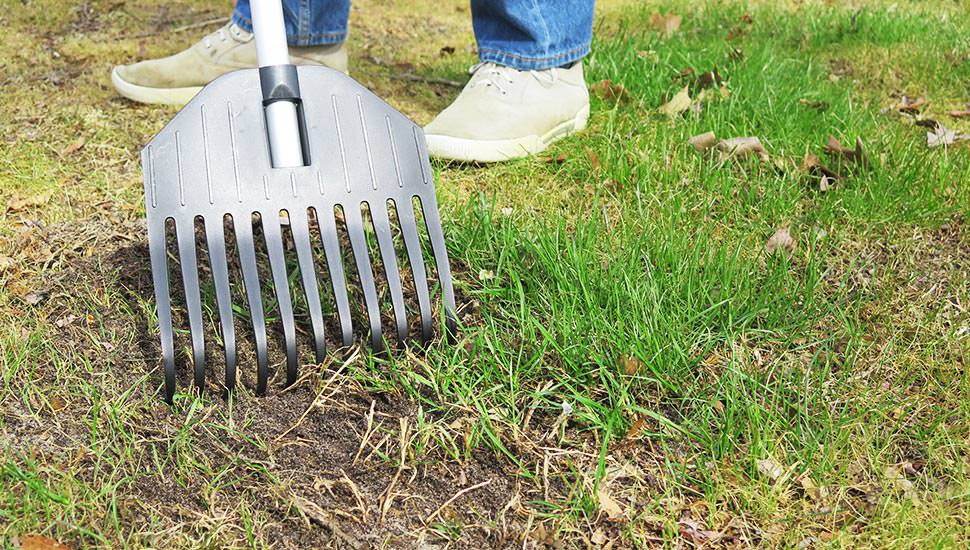

What is that ugly blemish in your beautifully manicured lawn?! Nothing is more frustrating than a gorgeous green lawn dotted with an unattractive bald spot or patches of dead grass. The rest of your lawn is thriving – so why are you seeing these spots? How do you fix a dead spot in lawn areas? Read on to find out!
Bare spots in lawn areas can be caused by a number of things, and knowing how to fix patchy grass starts with identifying your lawn issues. Take the time to investigate, and try to get to the bottom of your bare spot mystery before taking the steps necessary to correct the problem. Otherwise, you may continue to repair bare spots without addressing the actual cause.
Bare spots are often the result of:
Don’t worry if you can’t narrow down the exact cause of the bare spots right away. Just paying attention to the location and size before you begin to repair spots can make a huge difference. If the spot returns, then continue to investigate the cause.

Learning how to fix bare spots in lawn spaces is an essential part of lawn maintenance. The best method for grass spot repair is to overseed with new grass seed in the affected area. Overseeding, or planting new grass seed, allows for a healthy new start and can result in a virtually undetectable repair.
The best time to sow seeds for lawn patch repair depends on the type of grass you have. You’ll want to match the type of grass seed to what is already growing. Cool season grasses do best when planted in late summer to early fall. Warm season grasses perform best when the seed is sown in spring or early summer.
If you’re not sure what seed to use, give your local extension office a call. They can identify the perfect grass for your area and help figure out what types of grass will give you the quickest grass spot repair solution.
Seeding bare spots in lawn areas is a simple task that can be completed in just a few hours. It can take several weeks for new seed to turn into green grass, but the wait is definitely worth it.
Before you seed the area, get down and dirty by pulling weeds and removing any dead grass from the area. Grab a rake and roughen the soil in the bare spot and surrounding area. This will give the seeds a better chance to work into the soil and establish their roots quickly.
The best way to avoid overplanting – which causes weak and spindly grass plants – is to mix one part seed and three parts potting soil in a bucket. This gives you a seed application rate of approximately 10 to 15 seeds per square inch and results in the healthiest-looking grass patch repair.
Spread the seed and soil mixture evenly over the bare soil and slightly into the surrounding grass area. A slight overlap is just fine – you don’t want to see any evidence of the patch job once the grass grows back in.
Covering grass seed isn’t necessary, but it can be helpful to give the seeds a boost of nutrients with a light covering of fine compost. Once covered, gently walk over the area and tamp the seeds down into the soil.
Seeding bare spots can often draw in songbirds looking for a free meal. If you have a large (and hungry) bird population, you might want to add a loose layer of straw over the seed just until it germinates. Remove the covering as soon as seedlings appear, or you may weaken the young plants.
Now, water well. A nozzle with a light spray, such as the “flower” pattern on Gilmour’s Thumb Control Watering Nozzle, will soak the seeds and soil without washing anything away. Don’t hold the nozzle too close to the ground or turn the water on too high. Adjust the flow with the thumb control lever on the nozzle.
While the seeds are germinating, water them once or even twice per day with a nozzle, or use a small stationary sprinkler with a spray head just large enough to cover the patched area. Leave the water on the area for only a few minutes before moving on to the next spot. Water just enough to keep the spots moist.
As the seedlings grow to the height of the surrounding grass, gradually taper off watering until the former bare spot is eventually on the same watering schedule as your surrounding lawn.
Give new seedlings time to grow and strengthen before mowing. Resist the urge to mow the new grass until most of the seedlings in the new area are over 3 inches tall.
Once you know how to plant grass seeds in bare spots around the yard, take quick action to restore your lawn to a lush – and unblemished – place for your enjoyment all year long.
Circular Sprinkler with Simple Setup
We’ve reimagined the design of the traditional sprinkler and simplified it. Now, setting the radius, distance and flow is simple and stress free. Our innovative shape control means customizing your sprinkler’s coverage
Learn MoreRectangular Sprinkler with On/off Switch
Through innovative design and technology we’ve created a sprinkler that’s easy to use, simple to adjust and intuitively customizes to fit your lawn. Our clever on-off flow control switch requires just one
Learn MoreLandscapers make their living by planting and maintaining beautiful gardens. It’s their job to make sure that trees are planted properly, shrubs are pruned at the right time and flowerbeds flourish over
Get the Tips